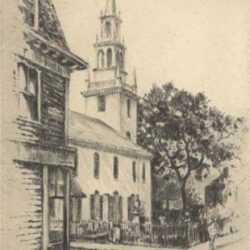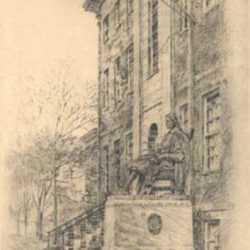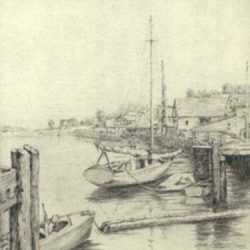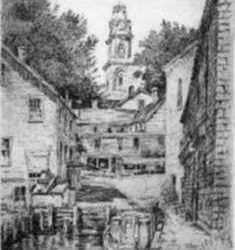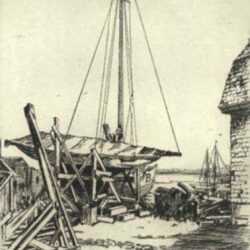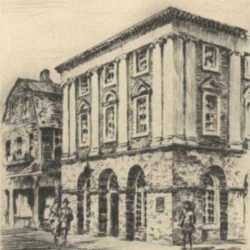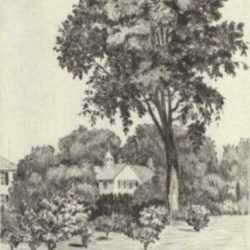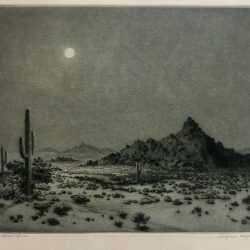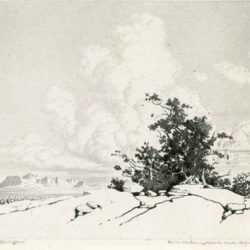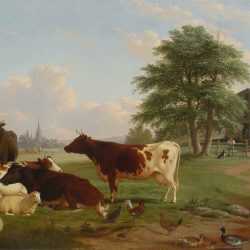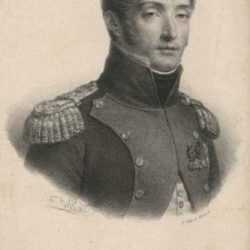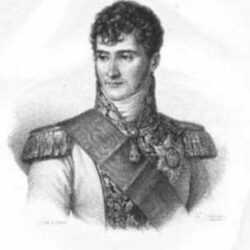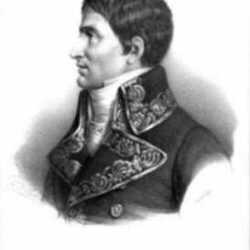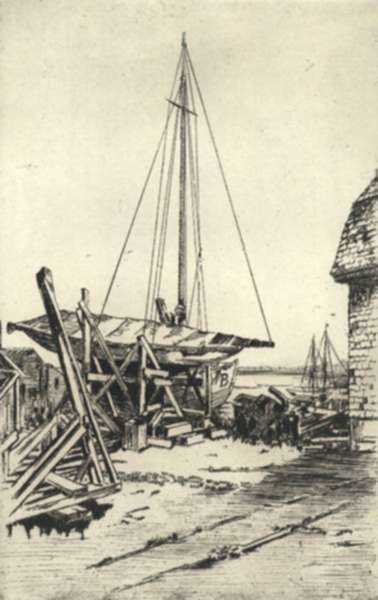Filter by Type
Filter by Category
Filter by Size
Filter by Year
Artists
Works by John R. Chapin
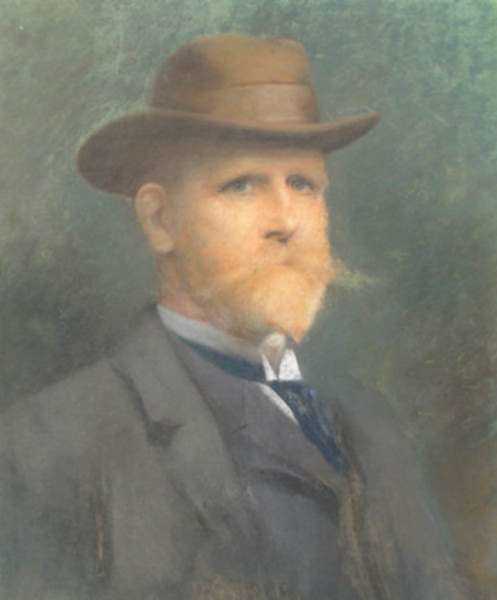
James Wells Champney
American (1843-1903)
In October of 1895, in an interview with "Art Amateur", James Wells Champney gave an autobiographical overview of his career.
"I was born in Boston Mass., on July 16, 1843. As I had always shown a liking for art, and my people were determined that I should have a paying trade, we compromised upon wood-engraving, and to a wood-engraver I was apprenticed at age sixteen. I did not remain long at the bench, however, luckily for me. We know in what straits the poor wood-engravers are in now. I wanted to be an artist. At the outbreak of the Civil War I went to the front for nine months with the Forty-fifth Massachusetts Regiment, and on my getting home began to draw upon wood for the engravers, instead of returning to work as one of them. My eyes became weakened by the constant strain of the fine pencilling then thought requisite, and in 1866, at the age of twenty-three, I went abroad, studying first in Paris as a pupil of Edouard Frère. My good teacher, however, soon perceived that I had not had the drill that was necessary to profit by his instruction, and he packed me off to Antwerp, where I spent a year perfecting myself in drawing. My first successful painting, a little genre piece, I sold to Goupil in 1869. I soon after returned to America, where I kept on painting genre subjects, signed ‘Champ’ to distinguish them from the works of other artists of my name, and with the exception of a few sketching trips for the magazine, there is little else to record until I began to practise in pastels in 1885.
Up to that time I had worked in oils and played in watercolors. I now found that pastels were both work and play to me. I was encouraged, too, by the appreciation of the public, expressed, as it always ought to be, in cash. I went again to Europe in 1890, for the express purpose of seeing the best pastels in the various great galleries and, in particular, to examine the condition of those that were painted one hundred and fifty years ago. I found them, for the most part, as bright, as delicate, and as charming as when they were painted. I need not dwell on the incomparable advantages of the medium. Its natural morbidezza has been imitated in oils of late years by some of the so-called impressionist painters. It is not suitable for minute work, and it constrains a man to broad handling. It is the art of all arts for the colorist; and the ease, rapidity, and certainty with which one can work in it, without being obliged to wait for colors to dry, or needing to risk hazardous combinations of pigments, should recommend it to every sincere student."
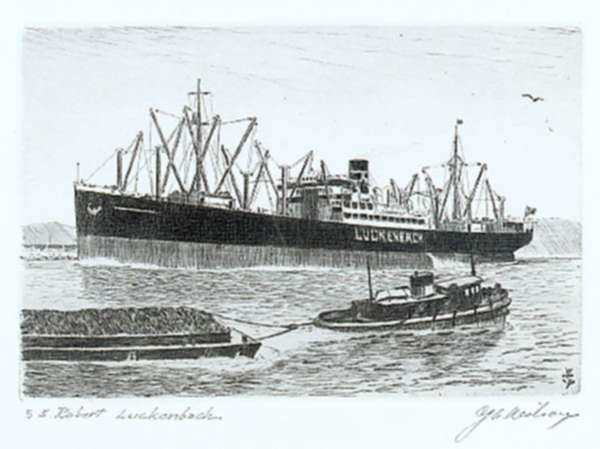
C. J. A. Wilson
American (1880-1965)
Charles J. A. Wilson was born in 1880 in Glasgow, Scotland. He came to America as an infant and was raised in Newton, Massachusetts. Wilson was a member of the Boston Society of Printmakers, and exhibited with Pennsylvania Academy of the Fine Arts, Society of American Etchers and the Currier Gallery. Wilson was a prolific, self-taught, marine artist and he gained much of his experience from working in the Boston shipyards. He worked as an artist for Bethlehem Shipbuilding in East Boston, etching their ships from blueprints, and during World War II, Wilson worked in Boston as an official Coast Guard artist. Our extensive collection of Wilson prints includes such ships as the S.S. Antigua, the U.S.S. Michigan, the Benjamin Packard, the Argus and the Holly of Boston. Wilson's works are in the collections of the Peabody Essex Museum (Salem, MA), the U.S.S. Constitution Museum (Boston), the Hart Nautical Museum at M.I.T., and the Penobscot Marine Museum in Searsport, Maine.
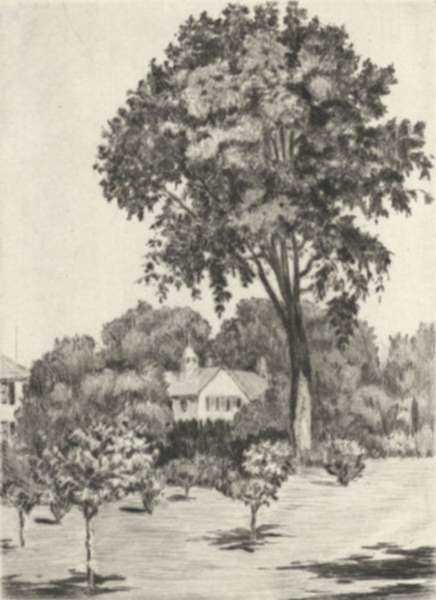
Paul Lameyer
German-American (1885-1960)
Paul Lameyer, German-American (1885-1960)
Paul Lameyer was born in Hanover, Germany October 30, 1885. He was educated at the Kaiser Wilhelm Gymnasium for thirteen years. He then spent five and one-half years at the Technology School in Munich where he gained a degree in engineering. He entered the German army where he served from 1906-1907 in the cavalry and infantry. He re-entered the German military in 1916 in the German air force through 1918. His family were wealthy Hanover jewelry merchants and supported Lameyer as an amateur on the international tennis circuit and he spent much of the 1920s in Italy. During 1922 he created a series of drawings of Venice which he later turned into etchings. He read and spoke German, French, Italian, and English.
In 1926 the artist met Helen Hunt Ames of Newton, Massachusetts. He moved from Italy to Massachusetts in September of 1926 and married Ames in the same year. They had two children, Louise and Gordon. In 1927-1928 he worked for the Boston architectural firm of Cram and Ferguson on Boylston Street for $60.00 per week as a designer. He then moved to the firm of McInnis and Welch in the Statler Building in Boston in a similar post from 1928-1933 for $70.00 per week. While he was employed in Boston during these years, Lameyer also had an income from investments in Germany providing an additional $8,000 per year until his assets were frozen by the Nazi government in 1933. Documents filed by the F.B.I. during 1942 stated that Lameyer still had “approximately $100,000 invested in Germany.” After the freezing of these assets, Lameyer worked under his own name as a designer, draftsman, and printmaker. His principal output of etchings was from 1933-1941, and his entire body of printmaking may date from this period. During that period he earned an average of $1,500-$1,600 per year.
On December 21, 1927 the Boston Evening Transcript reported that:
Kilham, Perrin, Lameyer Display Water Colors at the Architectural Club
Water colors are informally shown by three exhibitors at the Boston Architectural Club, 16 Somerset Street… Paul Lameyer undertakes detailed study of architectural bits, capitals, carvings, their introduction into dominant building schemes in other water colors as well as pen and ink drawings made abroad. There is an absence of titles, but surely the three studies framed as a triptych represent the time devastated wealth of the Roman Forum, while the bronze horse of St. Marks stands aloft in a study of Renaissance facades.
Lameyer lived with his wife and children at 300 Highland Street, West Newton, Massachusetts from October 1927 until October 1938. He then moved to 248 Mt. Vernon Street, Newton from October 1938 to June 1941; 50 Gloucester Street in Boston from July to September 8, 1941; 353 Marlboro Street, Boston from September 1 – 20, 1941; 249 Marlboro Street, Boston from September 20 to Dec 8, 1941.
Lameyer, a subject of investigations into wrongful internment of German citizens during WW II, was taken into custody by the F.B.I. at 249 Newbury Street in Boston on December 11, 1941 at 6:15 p.m. Since his loss of regular work and the ending of his German income in 1933 he had had less and less income to provide for his family. Apparently Helen Ames Lameyer did not prefer Paul poor. The action of the F.B.I. took place during a pending marriage separation action instituted by Mrs. Lameyer which Paul had apparently resisted – the couple never divorced. In affidavits Boston attorneys representing Mrs. Lameyer’s uncle, Major Ames of California, asserted that Mrs. Ames’ family had been supporting her and the children with as much as $20.00 per week and that Paul had refused to work. Furthermore the attorneys asserted that he was “definitely pro Nazi.” Lameyer was then interned in camps ranging from Massachusetts to Long Island, Tennessee, and North Dakota. On June 11, 1945 he was released from Ft. Lincoln, Bismark, North Dakota. Asked if he wished to be repatriated to Germany, he declined stating that his children were in the United States. His wife never gave his letters to their children during his imprisonment, returning them to him instead. He died in 1960.
Official parole documents, issued at the end of the war, stated that Paul Lameyer was in fact never a Nazi. He had been the victim, like many WWII internees, of false testimony, exaggerated war hysteria, and the personal motives of those who gave testimony against him. The secret wartime tribunal system that imprisoned him lacked the checks and balances of due process normally associated with an open court and it took 3 and a half years for the facts to surface that ultimately lead to his parole. He made drawings in the camps in which he was interned that are among the most valuable visual resources that were made by internees of the conditions in those camps.
We are grateful to Randy Houser, Paul Lameyer’s grandson, for bringing much of the material in this biography to our attention. The last paragraph was directly quoted from him.
Works by George Elbert Burr
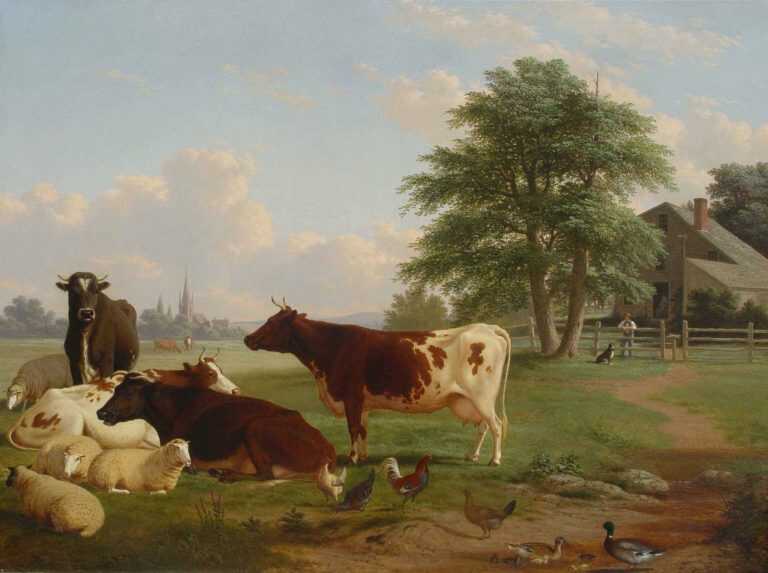
Thomas Hewes Hinckley
American (1813-1896)
Thomas Hewes Hinckley was born in Milton, Massachusetts in 1813. In 1829, he went to Philadelphia where he became a merchant's apprentice; while there, he also attended an evening class in drawing at the home of the artist, John Mason. In 1833, he returned to Milton, first finding employment as a sign painter and later as a portraitist. In neither of these areas, however, did Hinckley succeed as he did in the painting of domestic and game animals. Tuckerman placed Hinckley among those animal artists who had "...made familiar and progressive a class of pictures long prized in Holland, France, and England" by "...illustrating some of the most characteristic traits of animated nature, and making apparent their subtle relation to humanity". Hinckley's patrons were frequently wealthy local squires or gentleman farmers who commissioned portraits of favorite dogs or cattle, as well as landscapes highlighted by prize stock.
In 1851 he went to Europe to study the work of Sir Edwin Landseer, and two of his hunting paintings were exhibited at the Royal Academy in London. Hinckley also admired and was influenced by the work of the 17th Dutch painter, Albrecht Cuyp (1620-1691). In his notebook entries for 1860 he describes one painting, "Waiting for the Milkmaid", as "Group of Cows a la Cuyp, but better." The appeal of Hinckley's work to hunters and gentleman farmers meant that they sold without difficulty and without the need to be exhibited. However, Hinckley exhibited at the Boston Art Association (1844), the Pennsylvania Academy of the Fine Arts in Philadelphia (1848, 1855) The National Academy of Design (1846), the Boston Athenaeum (1863) the Boston Art Club (1873), the Massachusetts Charitable Mechanic Association (1874) and the American Art Union in New York (27 pictures between 1845 and 1852), the Centennial Exhibition in Philadelphia (1876), and the San Francisco Art Association (1872)-as well as many others. Hinckley's work is well represented in many fine public and private collections including The Metropolitan Museum of Art, the Museum of Fine Arts, Boston, Wadsworth Athenaeum, Hartford, Corcoran Gallery, Washington, North Carolina Museum of Art, Shelburne Museum, Vermont, Brandywine River Museum, Chadds Ford, Pennsylvania, National Museum of American Art, Society for the Preservation of New England Antiquities, Columbus Museum of Art, Columbus, Georgia, Albrecht-Kemper Museum of Art, St. Joseph, Missouri, and the Fruitlands Museum, Harvard, Massachusetts.
Works by Thomas Hewes Hinckley
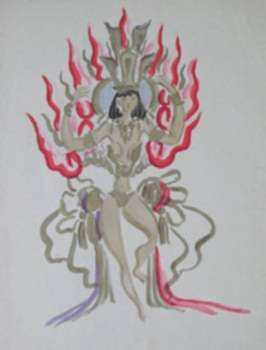
Raoul Henri Pène Du Bois
(1912-1985)
Raoul Henri Pène Du Bois, American (1912-1985)
Raoul Pène Du Bois was born on Staten Island, New York, the son of the banker René Pène Du Bois. Raoul was also the nephew of the painter, Guy Pène Du Bois ((1884-1958), and grandson of the writer, music and art critic for Hearst publications, Henri Pène Du Bois (1859-1906).
Costume designer, set director, and occasional art director Raoul Pene Du Bois began his long career at age 14, when he did four showgirl costumes for the Ziegfield Follies. He later was the designer for all of the costumes for the 1934 and 1936 Ziegfield Follies. At age 16 he designed his first Broadway musical Garrick Gaities and continued designing the costumes for musical revues and Broadway shows including works by Rodgers and Hart, Billy Rose, Leonard Bernstein, and Oscar Hammerstein. He worked on a number of big shows including The Music Man, Carmen Jones, Call Me Madame, One For the Money, Life Begins at 8:40, Two for the Show, Too Many Girls, and Kurt Weill’s Firebrand of Florence. Between 1939 and 1940, he designed Billy Rose's Aquacade for the New York World's Fair. He went on to design for ballets, ice shows, and other extravaganzas. Du Bois also designed costumes for the Rockettes.
He designed both the sets and costumes for Du Barry was a Lady, Panama Hattie, Lend an Ear, Alive and Kicking, New Faces of 1952, Plain and Fancy, Bells are Ringing, and Irene. Du Bois was nominated for and won a Tony Award in 1953 as scenic designer for Wonderful Town; nominated again in 1960 and 1964 for Gypsy and The Student Gypsy; was again a Tony Award winner in 1971 as costume designer for No, No Nanette, and nominated two more times, 1975 and 1980 as costume designer for Dr. Jazz and Sugar Babies. Walter Kerr, critic for the New York Times, described the visual impact of No, No Nanette as “an explosion of Halloween colors, whorls and zigzags, forever putting psychedelic to shame.”
Films he worked on include sets and costumes for Kitty, Frenchman's Creek, Lousiana Purchase, and Lady in the Dark—the latter two earning him Oscar nominations for Best Art Director (color) in 1941 and 1944.
Raoul Pène Du Bois died at age 72 on New Year’s Day 1985 in Manhattan.

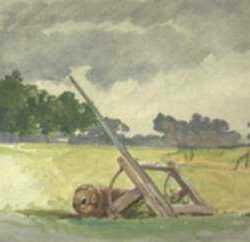
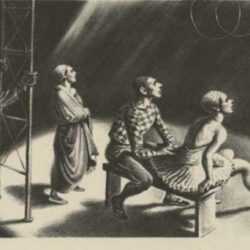
![Watercolor by John R. Chapin: [Hilly Landscape with Cows, New York State], represented by Childs Gallery](https://childsgallery.com/wp-content/uploads/john_r._chapin__hilly_landscape_with_cows__ne_cgl40138r_childs_gallery-1-250x250.jpg)
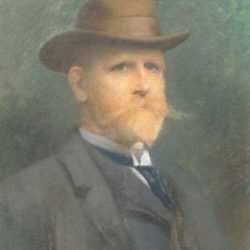
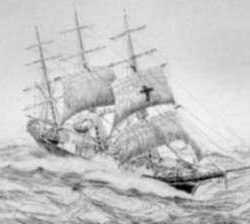
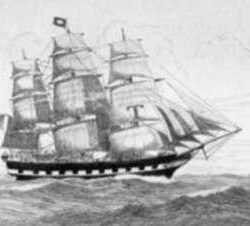
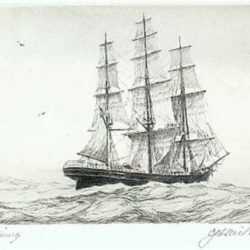
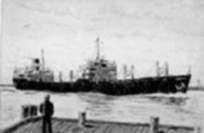
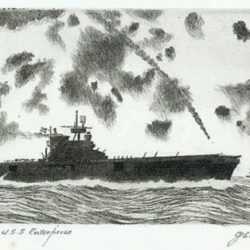
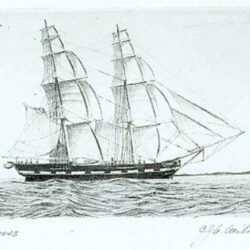
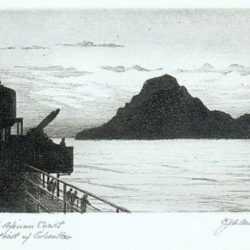
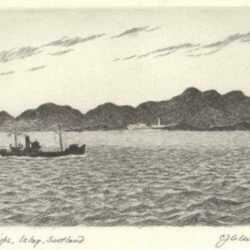
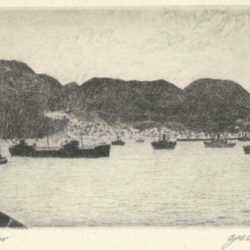
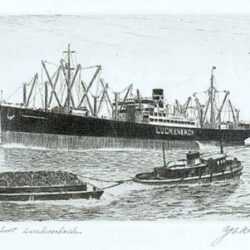
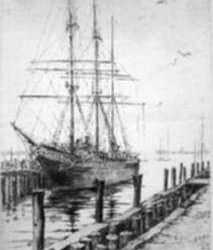
![Print by Paul Lameyer: Florence [Italy], represented by Childs Gallery](https://childsgallery.com/wp-content/uploads/paul_lameyer_florence__italy__p2065-24_childs_gallery-250x250.jpg)
![Print by Paul Lameyer: [Camden, Maine], represented by Childs Gallery](https://childsgallery.com/wp-content/uploads/paul_lameyer__camden__maine__p2065-28_childs_gallery-250x250.jpg)
